Looking to expand your luggage brand into the Chinese market? Here’s a look at some of the key ways to market and sell your products in China. From online platforms to brick-and-mortar stores, learn about the best ways to reach Chinese consumers and tap into this lucrative market. From leather 48H bags to smart luggage, the Chinese market is key for the premium luggage industry.
Steps to enter the Chinese Luggage Market
- Market Research
- Identify the key players in the Chinese luggage market
- Research the needs and wants of Chinese consumers
- Monitor market activity and adjust your marketing strategy accordingly
- Branding and reputation
- Develop a marketing strategy that resonates with Chinese consumers
- Key elements for a successful marketing campaign in china
- Develop Sales Channels
- Reach the right TA (target audience) in China
- Invest in Chinese Ecommerce
What is the Chinese Luggage market like?
The Chinese luggage and bag market is valued at US$17.15bn in 2022. A little slower than the previous years but a rebound is expected and the market should reach US$23.53bn by the year 2026 (Growth rate over 8%)

It is worth noting that more than half of sales in the Chinese luggage and bag market can be attributed to the market luxury segment. Suitcases and briefcases account for more than 26% of the total luggage and bags market.
Some key trends in the Chinese luggage market are:
- Premiumization
- Customization
- Convenience
- Innovative design and features (like a fingerprint locker)
What are the Challenges of the Chinese Luggage Market
China is the biggest manufacturer of luggage, but… Local brands that make low-quality products are facing some difficulties. This category of products includes poor-designed products and weak brand awareness. One should also notice that it is very difficult for Chinese brands to find stable distribution channels and settle solid marketing strategies.
These two elements seriously reduce the profitability of local luggage brands. Chinese brands don’t have advantages compared to foreign brands because international inspection requirements are becoming more demanding and consumers tend to favour premium brands more and more.
China’s E-commerce Growth and Distribution Changes
The internet has transformed the way businesses operate in China. The widespread adoption of mobile devices and increasing access to high-speed internet has made it possible for businesses to reach a large number of potential customers online. This has created new opportunities for businesses, especially in the e-commerce space.
Over the past few years, we’ve seen a tremendous increase in the number of Chinese consumers shopping online and this trend is easily verifiable for the luggage and bags market as per shown in the graph below. Between 2018 and 2024, the online share of luggage sales should rise from 47% to 64%.

Enter the Chinese Luggage Industry with a Market Research
- Understanding the level of demand for your product or service: China is a vast and complex country with over 1.4 billion consumers. It’s important to clearly understand the level and extent of demand for your product or service across different regions within China. Additionally, you need to be aware of any potential cultural differences that could impact how Chinese consumers view and use your product or service.
- Developing an understanding of your competitors: In order to succeed in the Chinese market, it’s essential to have a good understanding of your competition – who they are, what they offer, and how they operate and so on.
- Having a personalized market entry strategy: Depending on the current trends and competitors’ brand mapping, you will have a better sense of your future position in the market. You need to build a blue ocean around you and get a unique strategy to reach and seduce your target audience.
Identify the Key Players in the Chinese Luggage Market
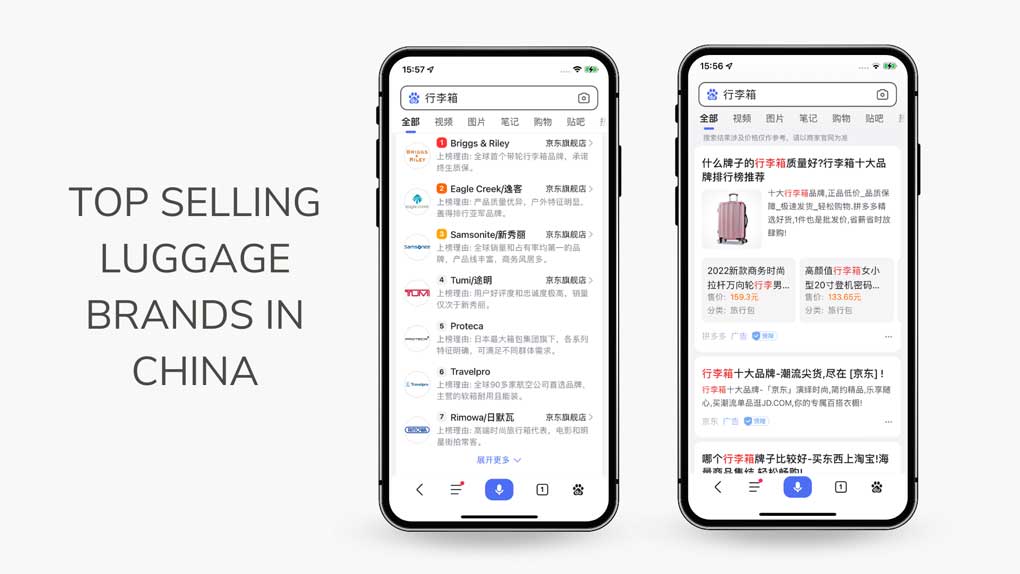
Research the Needs and Wants of Chinese Consumers
There is no one silver bullet when it comes to understanding Chinese consumer needs. However, some useful market research tools include online surveys, focus groups, and interviews. We can build your buyer personas and select from 10 to 25 people to conduct qualitative interviews asking them:
- How often do you use luggage when you travel?
- What are the most important criteria to purchase luggage? Rank from 1 to 10
- What is your favourite type of luggage and why?
- etc…
Another important factor to consider is that due to the vast size of the Chinese market, it is often necessary to conduct localized studies in order to get a more accurate picture of consumer needs and preferences. This can be done through intercept surveys or by working with local research partners who understand the cultural nuances and purchasing habits of consumers in different regions within China. Based on the provinces and cities you want to target, we can for instance select a pool of interviews living in these areas.
Monitor Market Activity and Adjust your Marketing Strategy Accordingly
The Chinese market is incredibly complex and ever-changing. What might be a hot trend today could be irrelevant tomorrow. A brand that does not keep up with the latest trends and developments in the Chinese market will quickly fall behind its competitors.
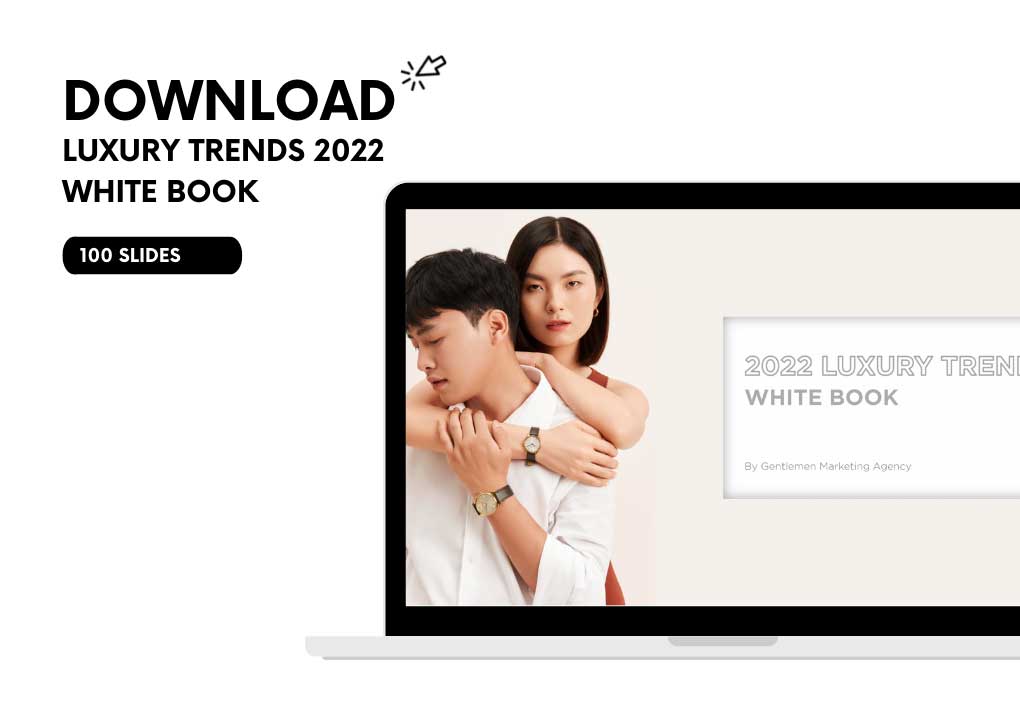
Consumer behaviour in China can vary significantly from region to region. What’s popular in Shanghai may not be popular in Beijing, and what’s popular in rural areas may be totally different from what’s popular in the cities. A brand that doesn’t have local market experts who can track these regional differences will miss out on important opportunities.
Branding and Reputation: Key to Success for your Luggage Brand in China
One should know while starting a business in China that your brand which is a symbol of your image is even more important than the product you are selling. Many things are related to your image but your website is essential because it draws your identity. We can help you to design your website in order to make it very attractive. You need to think about the values you have to put behind your brand and that is exactly your target. Thinks about the lifestyle that has your customers.
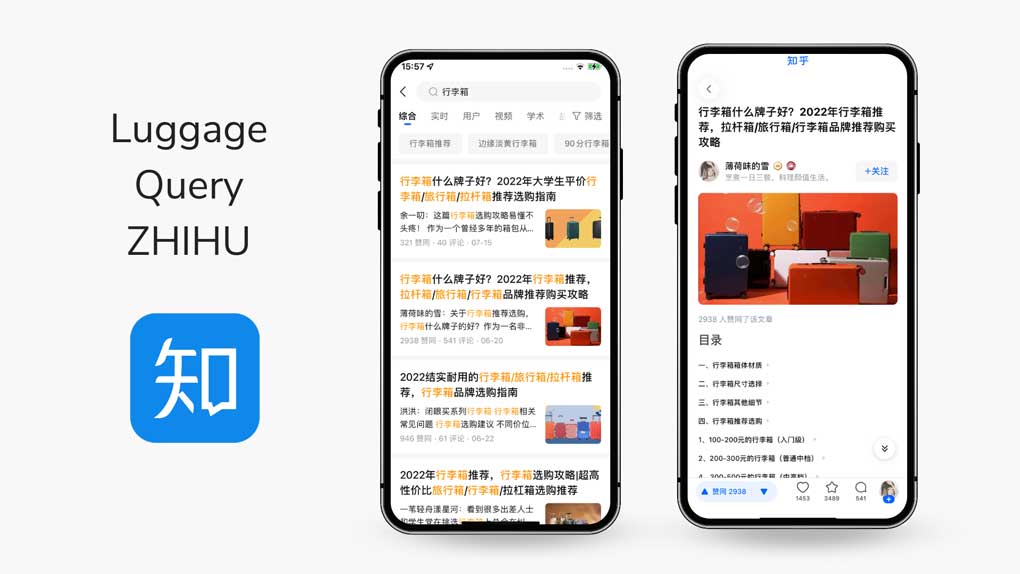
Develop a Marketing Strategy that Resonates with Chinese Consumers
There are a few key reasons why you need to develop a marketing strategy to succeed in China. Here are some of the most important ones:
- The Chinese market is extremely competitive. If you want to be successful, you’ll need to differentiate your brand and offer something that is appealing to Chinese consumers.
- Chinese consumers are very savvy when it comes to marketing and they are often quite mistrustful of advertising claims. You’ll need to build up trust with your target audience and create campaigns that resonate with them emotionally.
- The Chinese market is constantly evolving and changing, so you’ll need to be agile and responsive in order to keep up with the latest trends and changes in consumer behaviour.
Key Elements for a Successful Marketing Campaign in China
There are many necessary elements for a successful marketing campaign in China, but some of the most important are localization, cultural understanding, and deep knowledge of the Chinese media landscape.
Localization is key in China, as it is imperative to tailor your messaging to fit the local culture and preferences. Cultural understanding is also critical, as you’ll need to be aware of the nuances that drive Chinese consumer behaviour. In China, Rimowa understood the current trends and habits of local consumers. In Chinese netizens’ minds, this brand is a reference for premium and high-quality luggage. They will always compare your brand and newcomers to Rimowa.

And finally, having a deep knowledge of the Chinese media landscape will give you an edge in getting your message out to the right audiences. With so many different media outlets and platforms in China, it can be difficult to know where to start.
Chinese Social Media to Promote your Luggage Brand in China
Social media provide you with good support for communication and promotion in China. WeChat, Weibo, Little Red Book, and Douyin are some of the most popular social media in China. They appeal to different users base and benefit your brands in different ways.
For instance, Weibo will help you build a huge following and get a lot of visibility through its many marketing features (Paid ads, hashtags, KOL marketing…). You will have access to large influencers and KOLs to launch endorsement campaigns like Rimowa and @Sy__Jessica.

If your target is women from 1-tier and 2-tier cities interested in premium luggage, then definitely invest resources in the Little Red Book app. It is an excellent tool for ORM (Online Reputation Management) and UGC (user-generated content). Consumers use the little red book not only for the visual (Instagram kind of use) but also for the products and brand reviews through what the app calls “shopping notes”.

Brands can also open an integrated online store one the Little Red Book (also called Xiaohongshu in Chinese) for a perfect social e-commerce experience. Since RED does not accept outbound links anymore, you cannot directly promote your Tmall store but you can promote your RED store. While posting lifestyle pictures you can incorporate the e-commerce link to enable your followers to directly purchase on the app.
There are many Chinese social media that you can use to promote your brand. We would suggest that you get started with Wechat and Weibo marketing if you have budget constraints.
NB: The number 1 rule to succeed as a brand on Chinese social media is registering a business account. It gets you credibility with the app users and access to all the marketing features of the apps you are using.
Develop your Sales Channels in China
There are a few different channels to sell luggage in China.
- One option is to work with distributors who can help you reach retail stores throughout the country.
- Another option is to sell online through e-commerce platforms such as Tmall or JD.com
- Social media and e-commerce apps such as Little Red Book
- A combination of the 3 above options
Create a Strong Distribution Network in China
Finding reliable Chinese distributors is more complex than just mass mailing your product listing. In order to be noticed by distributors in China, you’ll need to put similar resources into branding as you would if you were to be doing direct selling.
There are a few benefits of selling your products through a distributor in China:
- A good distributor will have a well-established network of contacts and be able to help you reach buyers in China quickly and easily.
- Working with a distributor can save you time and money, as they will handle many of the logistics and administrative tasks related to selling in China (including translation, shipping, customs clearance, etc.).
The key downside of selling products through distributors in China is that
- You have less control over pricing and your overall market strategy. In addition, the distributor may not be as invested in marketing and promoting your product as you are, which can limit its potential exposure and growth.
- Language barriers can also make communication and coordination challenges, which can lead to misunderstandings or missteps.
- Finally, working with a distributor inherently means sharing profits, so it’s important to carefully consider whether this arrangement is economically viable for your business.
Invest in Chinese E-commerce
There are many benefits of selling your products with e-commerce in China. Perhaps the most obvious benefit is the potential to reach a much larger audience. With more than 780 million online shoppers, China is the biggest e-commerce market in the world. With almost a third of luggage and bags being sold through online channels in China, it would be a shame to ignore this channel.

Another advantage of selling through e-commerce channels in China is that you can avoid some of the challenges associated with traditional brick-and-mortar stores, such as high rental costs and inflexible leases. Selling online also gives you more control over your inventory and pricing, and makes it easier to track customer behaviour and so on.
China has many e-commerce platforms to choose from…
Depending on the positioning of your luggage brand on the market, your target audience, your budget and so on… you’ll be happy to hear that there is a marketplace for you.
- Leaders in e-commerce: Tmall and JD if you want to go big and your brand is mid-prize to high-end
- Platforms dedicated to Luxury: Tmall Luxury Pavilion, Fartfetch, Secoo, Xiaohongshu
- Affordable platforms: Pinduoduo and Taobao for brands with small budgets or targetting consumers with smaller incomes
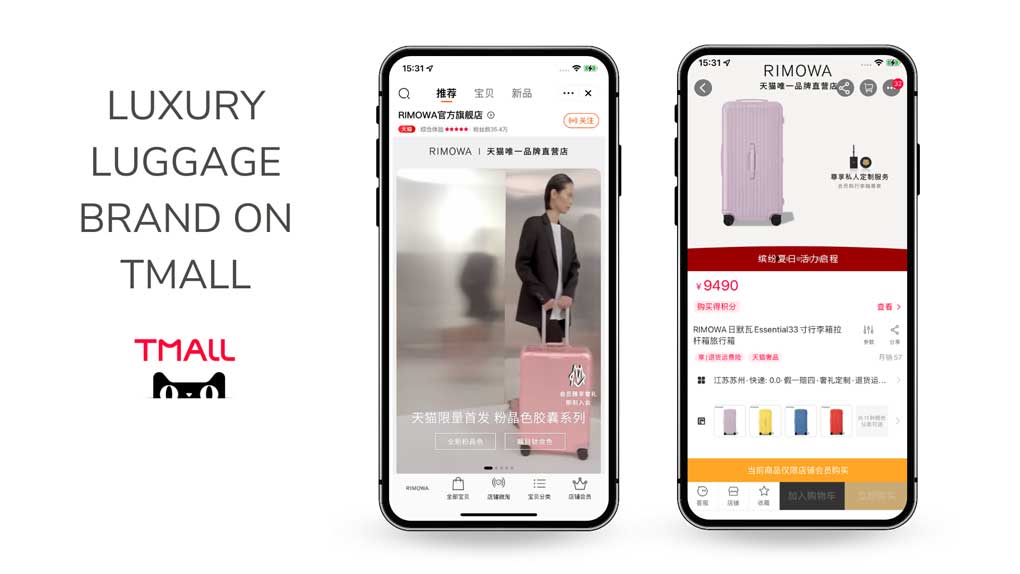
Cross-border eCommerce is the perfect entry door for foreign luggage brands into china
Entering the Chinese e-commerce market through a “local” app can feel daunting, especially for brands that still feel luck warm about it. Cross-border eCommerce is giving a great opportunity to brands to try out the market without fully committing. Many e-commerce platforms enable international brands to open and run cross-border e-commerce stores like Tmall Global, JD International, and RED (Little Red Book e-commerce part). You can decide to open only 1 store on 1 platform to maximize the investment concentration. Or you can decide to open several stores on different platforms with different purposes and TAs.
Most Chinese e-commerce platforms offer a cross-border option. The most popular with merchants and consumers are Tmall Global, JD Worldwide and RED. For luggage, brands should favour a Tmall or a RED depending on their price positioning and TA.
Selling a luggage brand in china: do you need help?

We have a team of experts specialized in marketing, e-reputation and e-commerce. We have run several Tmall, JD, and RED stores to help brands successfully enter and develop in the Chinese market. Each project is different, it mainly depends on your assortment, positioning, and pricing.
Contact us, we can help you!

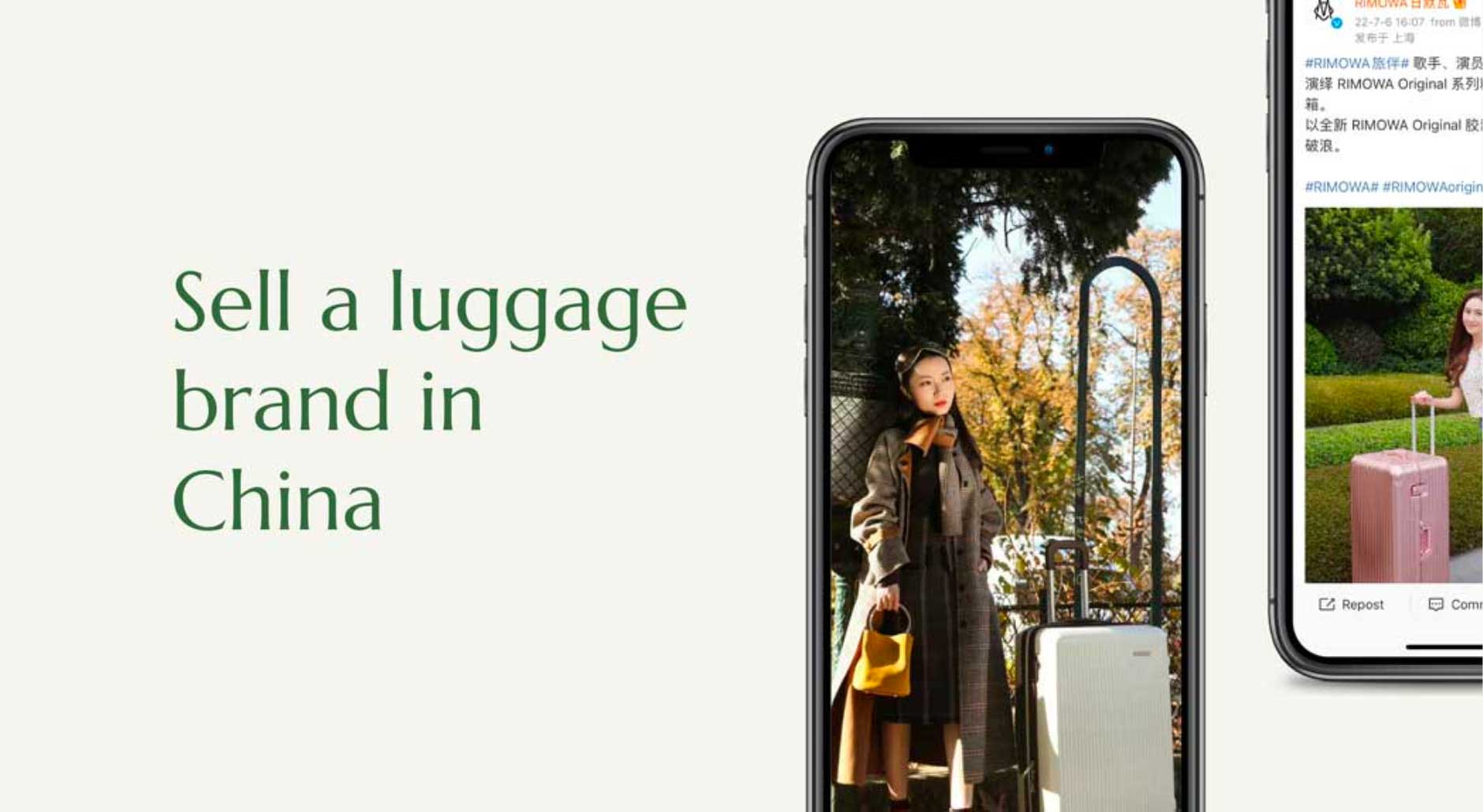
1 comment
Marina
Very interesting! Didn’t know about a luggage market in China